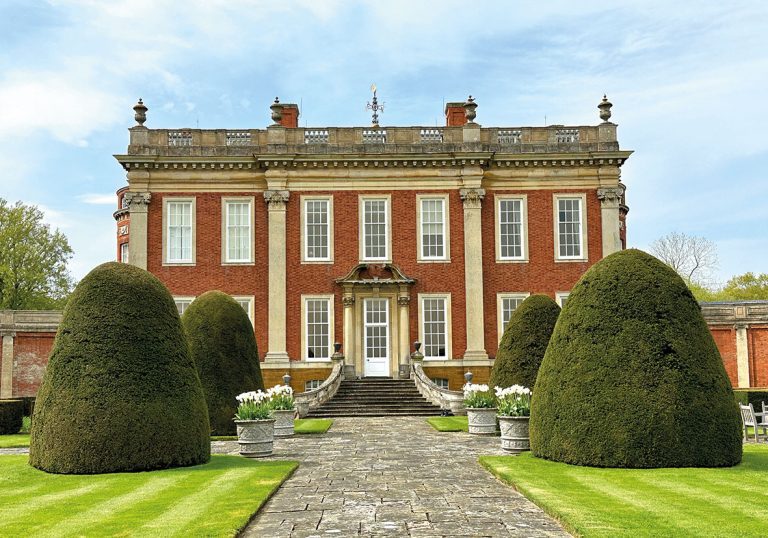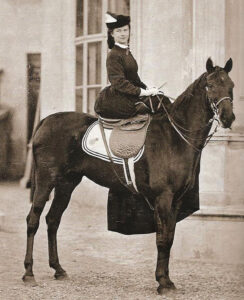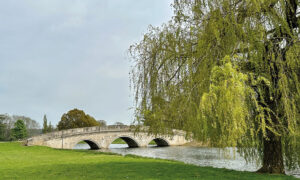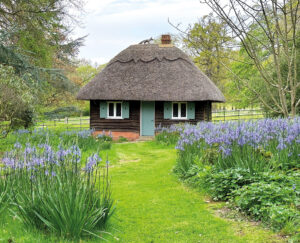Charmed by Cottesbrooke
Posted 18th June 2023
This month I’m taking the rare opportunity to visit one of Northamptonshire’s loveliest estates. It’s a rare treat as it opens to the public for a few days a week over summer months only, but it’s so worth a visit, writes Laura Malpas. You can expect glorious gardens and parkland, and a grand house that manages to feel inviting and cosy despite its grandeur. In the words of my guide, ‘this house feels like a hug’.
The ancient village of Cottesbrooke is set in the heart of rural Northamptonshire. It’s quite central to the county, halfway between Northampton and Market Harborough.
The Cottesbrooke estate was purchased in 1635 by a wealthy gentleman from Cold Ashby, John Langham. John’s background was humble, but he had ambition. After his father died, John argued with his widowed mother and left home for London on foot, vowing never to return until he had made his fortune.
John apprenticed himself to a ‘Turkey Merchant’, learning how to trade in the Eastern Mediterranean. He quickly gained the trust of his master, acting as a merchant buying and selling on commission. His success enabled him to build up capital to trade on his own account, and coupled with his wife’s dowry, he attempted to pull off an extremely smart deal to make his fortune.
Raisins were an affordable luxury in the 17th century, as a source of sweetness, and always highly in demand. John decided to buy up as many as he could and acquired half of the consignment destined for the English market. But tragedy struck! The ships importing his stock were lost at sea, along with the fruit and most of his fortune. Undefeated by his loss, John managed to get back to London before the news broke, and as the other half of the raisin stocks arrived into port at Chatham, he purchased them all. He now had a monopoly which enabled him to clear a fortune of £30,000.
With this success, John and his wife finally returned home and purchased large estates in Northamptonshire including Cottesbrooke. John’s future seemed secure, his fortune and quick wits had bought him respect within the City of London, becoming an alderman and Sheriff of London.
But as a Royalist supporter his life became considerably more complicated during the civil wars. John sent funds and offered support to the exiled king, both risky political moves, and he was committed twice to the Tower of London. However, in 1660 the newly restored King Charles II rewarded his loyalty to the Crown by creating the Baronetcy of Cottesbrooke, making him Sir John Langham, and securing his family’s fortunes.
The story of Cottesbrooke Hall really begins in 1702 with the 4th Baronet, also named Sir John Langham. He decided to build a grand country house on his Cottesbrooke estate, choosing Francis Smith of Warwick, known for his scrupulous honesty and competence, to design and construct a fashionable residence in the style of Buckingham House in London.
The Hall has been described as a ‘near perfect example of Queen Anne architecture’. The Baroque-symmetrical house was set in sweeping landscaped parkland, and aligned on a vista which reveals the spire of Brixworth Church at its centre point. The warm rosy red brick laid on Duston ironstone and ornamented with beautifully carved Ketton stone has a very pleasing, almost comforting appearance. There were some significant additions in the later 18th century when full height bow windows were added at either end of the house, maintaining symmetry, and adding graceful curves to the otherwise strongly rectilinear profile. This also allowed for very attractive rooms inside the house with windows which make the most of the views of the landscaped gardens and allow the light to flood into the house.

Visitors to Cottesbrooke may tour the house with a guide and enjoy viewing the rich but still homely and comfortable furnishings, set in arcaded corridors, sweeping staircases and beautifully proportioned rooms. The house shows the personality and passions of the generations that have owned and loved Cottesbrooke. All have left their mark, leaving wonderful collections of fine things, including porcelain, elegant furniture, textiles and portraits.
But perhaps the most notable personality felt in the house is that of Lord Woolavington, great grandfather of the present owner. He was passionate about all things equestrian, and Cottesbrooke is the home of the finest collection of sporting art that I have ever seen, with many nods to the Pytchley Hunt. This includes paintings and sculptures of a previous famous guest, the glamorous Empress Elizabeth of Austria, also known as Sisi. Obsessed with horses and maintaining her own physique, in 1877 she leased Cottesbrooke to use as a base for hunting. Her beauty was best displayed on horseback, and there are several glamorous representations of her within the collection.

In 1937 the Lord Woolavington’s descendants, the Macdonald-Buchanan family moved to Cottesbrooke. Their impact is seen best in the gardens, where during the 20th century Lady Macdonald-Buchanan employed garden designers who took inspiration from the Arts and Crafts style, notably Robert Weir-Schulz, and the Baroque inspired Geoffrey Jellicoe. Together they have produced some of the most glorious spaces to be found in Northamptonshire.
On my visit, the sunlight dappled through the mature trees, spotlighting herbaceous blooms as I wandered through the many styled garden rooms. I discovered walks lined with statues, some classical, some whimsical. There are flower filled courtyards with sparkling pools, one even featuring a monkey smoking a pipe! And everywhere there are decorative stone and lead urns and troughs glowing with colour from the luscious planting. Together with the fragrance and birdsong the formal gardens provide a real treat for the senses. But there’s more!
A little way from the Hall, there’s a path leading to the Wild Garden, a carefully planned naturalistic walk alongside a canalised stream, crossed and recrossed with ornamental bridges and steppingstones. There’s a charmingly thatched Wendy House, and a pagoda style gazebo from which to take in the colourful shrubs and wildflowers.

Your wanderings may well work up an appetite, and I am pleased to tell you that there’s a lovely little courtyard tea room which serves beverages and cake. I’m a bit of a connoisseur of tea rooms, and although the offer is simple, it is very good indeed. You’re also welcome to take a picnic to enjoy in the dedicated area in the parkland along with beautiful views.
Cottesbrooke Hall and its gardens are open for a brief season in summer only, and if you enjoy an afternoon outing in our beautiful countryside, book now, don’t miss it!
> For more information about visiting Cottesbrooke Hall, please visit www.cottesbrooke.co.uk
